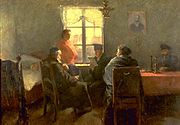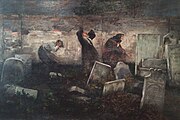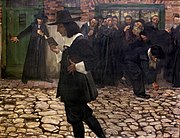Samuel Hirszenberg
Samuel (Szmul) Hirszenberg | |
|---|---|
 Self-Portrait, 1907 | |
| Born | February 22, 1865 Łódź, Poland |
| Died | September 15, 1908 (aged 43) |
| Education | Jan Matejko Academy of Fine Arts Academy of Fine Arts, Munich Académie Colarossi |
| Known for | Painting |
Notable work | The Wandering Jew, Exile, The Sabbath Rest, The Eternal Jew |
| Movement | Realism |
Samuel Hirszenberg (also Schmul Hirschenberg) (Łódź, February 22, 1865 – September 15, 1908, Jerusalem) was a Polish-Jewish realist and later symbolist painter active in the late 19th and early 20th century.
Biography[]
Szmul (Samuel) Hirszenberg was born in 1865, the eldest son of a weaving mill worker in Polish Łódź. Against the will of his father, but thanks to the financial assistance of a doctor, he chose to be an artist. At the age of 15 he began his studies at the Academy of Fine Arts in Kraków, where he was heavily influenced by the realistic painting of Jan Matejko.[1]
After two years of training in Kraków, he continued his studies from 1885-1889 at the Royal Academy of Arts in Munich.[2]
Art career[]

His first major work to attract attention was Yeshiva (1887). After an exhibition at the Kunstverein Munich (1889), he showed at the art exhibition in Paris and was awarded a silver medal. In Paris, he completed his artistic training at the Académie Colarossi.

In 1891, Hirszenberg returned to Poland. In 1893 he resettled in his hometown of Łódź. While the images of the early years, like the paintings Talmudic Studies, Sabbathnachmittag, Uriel Acosta, and The Jewish cemetery show a certain kinship with the Jewish genre painting by , Isidor Kaufmann, and Maurycy Gottlieb, his later works can be rather assigned to the symbolism. Themes of the "tearful" Jewish history came to the fore. Noteworthy are the three most famous pictures of this period: The Wandering Jew (1899), Exile (1904), and Czarny Sztandar / Black Flag (1905).
In 1900, after working on a large painting, "The Eternal Jew," for over four years, it was exhibited in the Paris Salon. Disappointed by the poor response in Paris Munich and Berlin, he retired for health reasons.[3]
In 1901, he went for a year on a trip to Italy. In 1904, Hirszenberg moved to Kraków. In 1907, he immigrated to Israel and began to work as a lecturer at the newly founded Bezalel School in Jerusalem, headed by Boris Schatz. After a short and intense creative period, he died in 1908 in Jerusalem.[4]
Selected paintings[]

The Sabbath Rest (1894)

Capri (1901)

Jewish Cemetery (1892), Musée d'Art et d'Histoire du Judaïsme

Spinoza, Excommunicated

Dome of the rock, Tel Aviv Museum of Art, 1908
See also[]
- Israeli art
- Maurycy Trębacz (1861–1941), Polish-Jewish painter.[5]
References[]
- ^ Cohen (1998). P. 223.
- ^ Entry for Samuel Hirschenberg in matriculation register (Matrikelbuch) from 1883.
- ^ Ruth (1902). Col. 685.
- ^ Schwarz (1949). P. 44-45.
- ^ "Maurycy Trębacz - zapomniany malarz żydowski". Cenne. Bezcenne. Utracone (in Polish). Narodowy Instytut Muzealnictwa i Ochrony Zabytkow, Warsaw. Archived from the original on March 7, 2016. Retrieved August 2, 2012.
Further reading[]
- Cohen, Richard I. (1998). Jewish icons: art and society in modern Europe. Berkeley: University of California Press. ISBN 0-520-20545-6. P. 223-235.
- Goodman, Susan Tumarkin (2001). The Emergence of Jewish Artists in Nineteenth-Century Europe. London; New York: Merrell. ISBN 978-1-85894-153-0.
- Ruth (1902). "Samuel Hirszenberg: eine biographische Skizze" [biographical sketch, in German]. In: East and West, vol. 2, issue 10. Columns 673-688.
- "Samuel Hirszenberg" in Jewish Encyclopedia, 1906.
- Schwarz, Karl (1949). Jewish Artists of the 19th and 20th Centuries. New York: Philosophical Library, 1949. P. 43-49.
External links[]
- Hirszenberg's works in Central Jewish Library
- 1865 births
- 1908 deaths
- Artists from Łódź
- 19th-century Polish Jews
- Jewish painters
- Jan Matejko Academy of Fine Arts alumni
- Academy of Fine Arts, Munich alumni
- Académie Colarossi alumni
- Bezalel Academy of Arts and Design faculty
- 19th-century Polish painters
- 19th-century male artists
- Polish male painters





